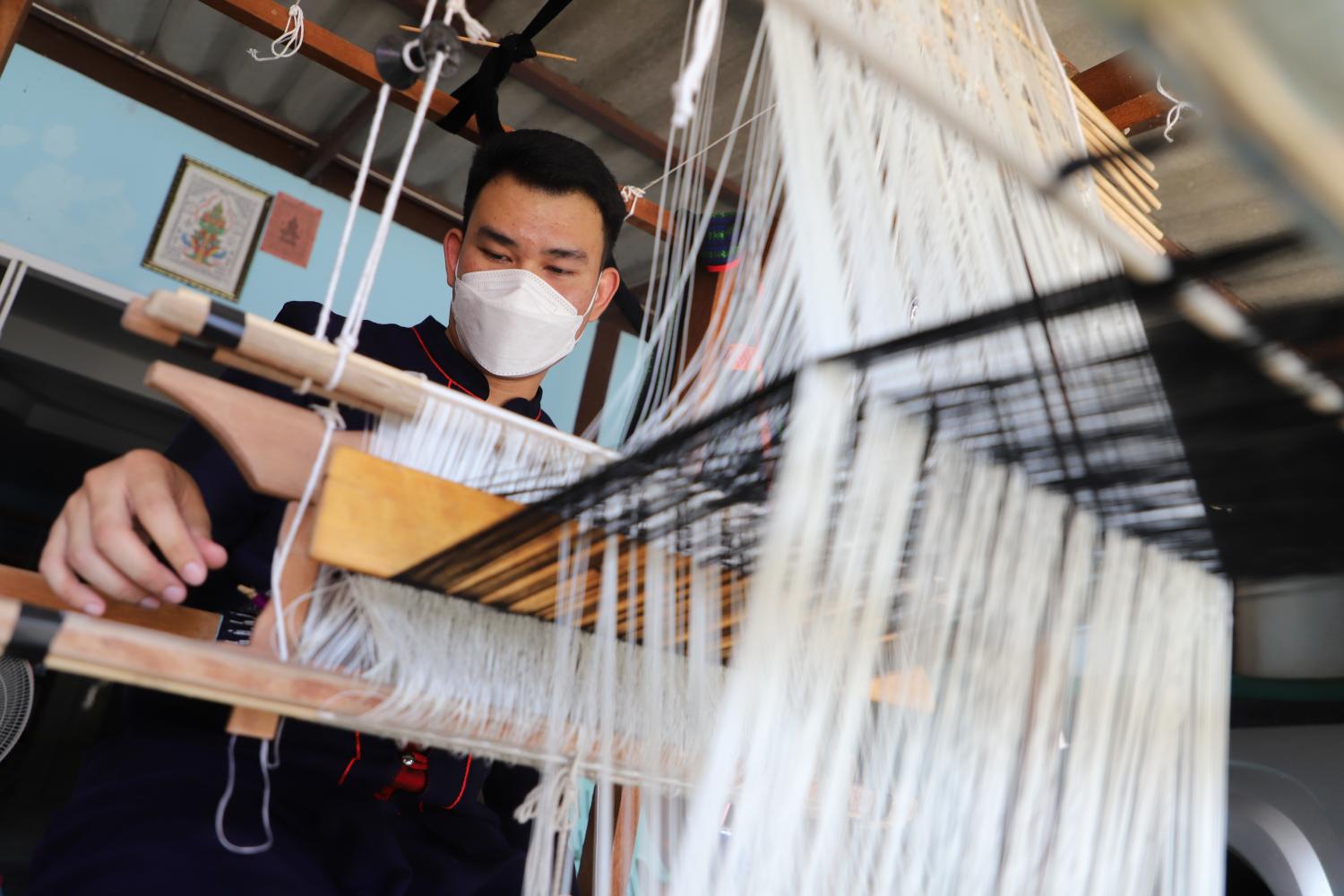
NAKHON PATHOM: The rhythm of cloth weaving from a wooden loom in a Tai-Yuan community in Kamphaeng Saen district can be heard again after it disappeared for over 50 years.
A 26-year-old man sitting behind the loom weaves with silk and cotton using a unique pattern -- based on knowledge that was passed from generation to generation.
Preservation movement
Warut Manprom, founder of Wong Duean Jok Tai-Yuan Group, said he started this weaving business because he wanted to help preserve Tai-Yuan ethnic textiles.
He also saw a great business opportunity from his predecessor's weaving wisdom. It inspired him to work closely with his partners in this Central Plains province to develop natural fabric cloth products based on his ethic identity.
Jok is a unique technique for inserting a thread to create wonderful patterns. He estimates the business could make 20,000 baht per month on average.
Mr Warut developed his cloth-weaving skills though by self-learning. He was encouraged by Her Royal Highness (HRH) Princess Sirivannavari Nariratana Rajakanya who advised him how to develop Tai-Yuan textile products.
Mr Warut met the princess at an exhibition to promote Thai textiles at Silpakorn University in Nakhon Pathom last year.
''The princess' advice gave me more confidence in the way I want to go: preserving the cultural heritage of cloth weaving,'' he told the Bangkok Post.
Nakhon Pathom, which is adjacent to Bangkok, has many ethnic communities. Most of them settled in the province over 100 years ago, such as the Tai-Yuan ethnic group, the Lao Khrang group and more besides.
These people have advanced skills in cloth weaving, consisting of blending colour, and coming up with precise patterns that usually represent their local life, beliefs and nature. Unfortunately, these skills have declined over time.

Princess' support
Inspired by HRH Princess Sirivannavari's initiative to preserve Thai-weaving (carrying on the work of Her Majesty Queen Sirikit The Queen Mother, her grandmother, to promote Thai textiles), Nakhon Pathom has worked hard to revive its weaving industry.
Waraporn Chareornsirichot, chairwoman of the Interior Wife Club there, said the governor is keen on retrieving the local wisdom in cloth weaving by supporting those communities.
The province offers weaving courses to develop their textile products and helps them seek out more marketing channels to distribute them.
The province is now promoting its unique Dvaravati pattern of pots, representing fertility and prosperity, and a crouching deer pattern to represent the land of Buddhism. Nakhon Pathom province is believed to be the centre of the Dvaravati culture which dates back over 1,000 years.
Dvaravati was an ancient Mon kingdom from the 7-11 century.
Ms Waraporn said the province has also trained prisoners in cloth weaving, which gets good feedback. ''Our strong point is that the price is reasonable. Most people can afford it. The local community can make money from the business, in line with the government's policy to strengthen community-based economies,'' she said.
Magic of natural dyes
Keangkard Toathongram, a lecturer at the Faculty of Humanities and Social Sciences, Nakhon Pathom Rajabhat University, who is also a natural colour expert, said he has been working with many communities to help develop their textile products, especially traditional methods of fabric dyeing.
Mr Keangkard said natural dyes from plants, leaves, flowers and fruits are full of unpredictable colours.
''We could see the same method of dyeing from raw materials, but different areas will give different shades.
''ll natural products can give colour, which needs a special technique and local wisdom. We never know the precise shade of colour until the dyeing is finished. That is the magic of colour from nature,'' he said.
Mr Keangkard cited the different shades of grey from a lotus branch, the purple from the fruit of a Sala tree, light yellow from pomelo leaves and more.
Conducting research into local fabric weaving by the Lao Khrang ethnic group in Phrong Madua of Muang district, he said HRH Princess Sirivannavari suggested he write a textbook on dyeing from natural materials.
Kamonpat Bokaew, 39-year-old founder of Lao Khrang Wat Phrong Madua, said the group has now shifted focus to natural colours.
She said most customers are concerned about health and environment and prefer to buy natural products.
''Cloth dyed from natural materials makes more money for the group, and is also in line with the intention of HRH Princess Sirivannavari to promote colours from nature,'' Ms Kamonpat said.
The Tai-Yuan and Lao Khrang communities made income from their cloth weaving businesses of 223,000 baht in 2021 and up to 500,000 baht in 2022.
Note: This is the last of a series of four stories about Her Royal Highness Princess Sirivannavari Nariratana Rajakanya's work in carrying out Her Majesty Queen Sirikit The Queen Mother's initiative to support, conserve and promote Thai textiles.







